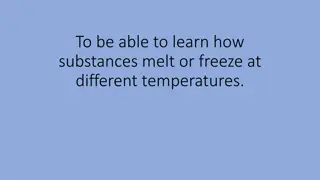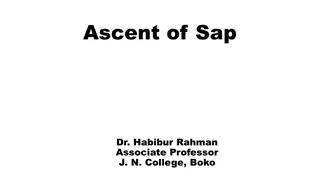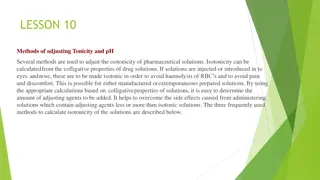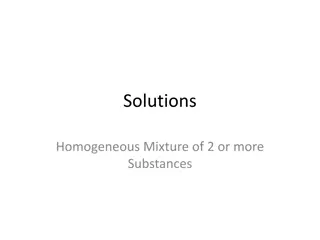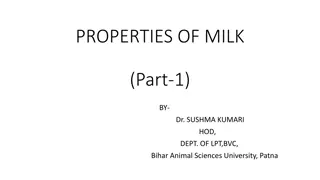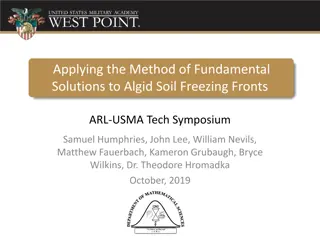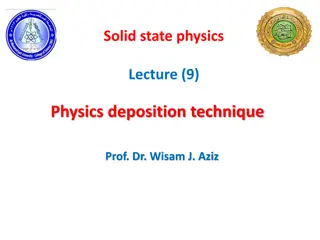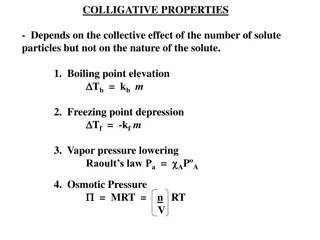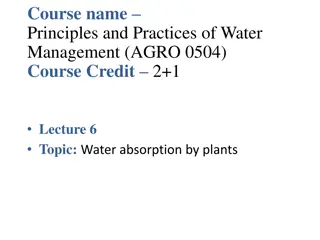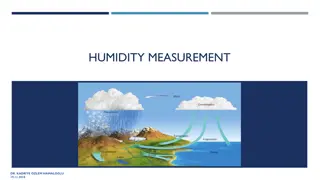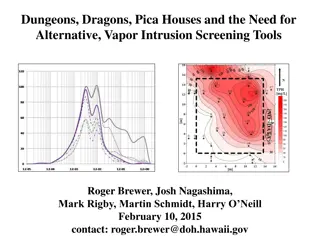Colligative Properties in Solutions: Vapor Pressure, Freezing Point Depression, and Osmotic Pressure
Colligative properties such as vapor pressure lowering, freezing point depression, and osmotic pressure are characteristics of solutions that depend on the number of solute particles present. This text explores how these properties are related to the concentration of solute in a solution and how they can be measured and calculated. Key concepts include the mole fraction ratio, vapor pressure lowering, freezing point depression, and osmotic pressure in dilute solutions.
Download Presentation

Please find below an Image/Link to download the presentation.
The content on the website is provided AS IS for your information and personal use only. It may not be sold, licensed, or shared on other websites without obtaining consent from the author. Download presentation by click this link. If you encounter any issues during the download, it is possible that the publisher has removed the file from their server.
E N D
Presentation Transcript
Nonelectrolytes 3 Assistant Prof. Dr. Fouad Al-saady
The mole fraction, n2/ (n1 + n2), is nearly equal to, and may be replaced by, the mole ratio n2/n1 in a dilute solution Then, the relative vapor pressure lowering can be expressed in terms of molal concentration of the solute by setting the weight of solvent w1 equal to 1000 g. For an aqueous solution, ???? ?????? ?? = ? ?? ??= ? ?? = ??.?= ?.??? ? Calculate the vapor pressure when 0.5 mole of sucrose is added to 1000 g of water at 20 C. The vapor pressure of water at 20 C is 17.54 mm Hg. The vapor pressure lowering of the solution is p = p1 X2 p1 x 0.018 x m = 17.54 x 0.018 x 0.5 = 0.158 mm The final vapor pressure is = 17.54 0.158 = 17.382 mm note : related to lecture nonelectrolyte 2 3
Depression of the Freezing point Freezing point is the temperature at which the solid and liquid phases are in equilibrium . liquid and the solid have the same escaping tendency. The depression in freezing point, like boiling point elevation ,is a direct result of vapor pressure lowering.
freezing point depression is proportional to the molal concentration of the solute ???? ?? ???? ??= ??? or ??= ?? Tf is the freezing point depression, and Kf is the molal depression constant or the cryoscopic constant, which depends on the physical and chemical properties of the solvent. The freezing point depression of a solvent is a function only of the number of particles in the solution, and for this reason it is referred to as a colligative property. 6
Osmotic Pressure In the process of diffusion, both the solvent and the solute molecules migrate freely. If the solution is confined in a membrane permeable only to the solvent molecules, the phenomenon known as osmosis occurs, and the barrier that permits only the molecules of one of the components (usually water) to pass through is known as a semipermeable membrane. This process tends to equalize the escaping tendency of the solvent on both sides of the membrane. 8
vant Hoff and Morse Equations for Osmotic Pressure van t Hoff concluded that there was an apparent analogy between solutions and gases and that the osmotic pressure in a dilute solution was equal to the pressure that the solute would exert if it were a gas occupying the same volume. V= nRT is the osmotic pressure in atm Vis the volume of the solution in liters nis the number of moles of solute Ris the gas constant, equal to 0.082 liter atm/mole deg, Tis the absolute temperature. One gram of sucrose, molecular weight 342, is dissolved in 100 mL of solution at 25 C. What is the osmotic pressure of the solution? 1 ???? ?? ??????? = 342= 0.0029 x 0.1 = 0.0029 0.082 298 = 0.71 atm 9
vant Hoff equation, can be expressed as ? ? ?? ? = ?? ? = ? ?? Where c is the concentration of the solute in moles/liter (molarity). 10
MOLECULAR WEIGHT DETERMINATION Lowering of the vapor pressure the mole fraction of solvent, n1 = w1/M1 mole fraction of solute, n2 = w2/M2 ? ?1 ?1 ?1 ?2 = ?1+ ?2= ?1?1) 11
MOLECULAR WEIGHT DETERMINATION Boiling point elevation ?2 1000 ?2 ?1?? ?? ? = ?1 ? 1000 = ??= ??? 1000 ?2 ?1?2 ??= ?? A solution containing 10.0 g of sucrose dissolved in 100 g of water has a boiling point of 100.149 C. What is the molecular weight of sucrose?( kb =0.51) H.W 12
MOLECULAR WEIGHT DETERMINATION Boiling point elevation By rearranging equation 1000 ?2 ?1?2 ??= ?? The freezing point depression of a solution of 2.000 g of 1,3- dinitrobenzene in 100.0 g of benzene was determined by the equilibrium method and was found to be 0.6095 C. Calculate the molecular weight of 1,3-dinitrobenzene.( kf = 5.12) H.W 13


